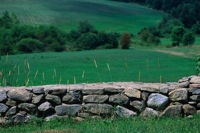Difference between revisions of "Boundary"
m (Text replacement - "http://nordan.daynal.org" to "https://nordan.daynal.org") |
m (Text replacement - "http://" to "https://") |
||
| Line 3: | Line 3: | ||
==Origin== | ==Origin== | ||
Old French ''bodne'', ''bone'', ''bune'', ''bonne'', ''bunne'', also ''bunde'', ''bonde'', 13th cent. Anglo-Norman ''bounde'' ''bound'' + ary | Old French ''bodne'', ''bone'', ''bune'', ''bonne'', ''bunne'', also ''bunde'', ''bonde'', 13th cent. Anglo-Norman ''bounde'' ''bound'' + ary | ||
| − | *[ | + | *[https://en.wikipedia.org/wiki/13th_century 13th Century] |
==Definitions== | ==Definitions== | ||
*1. A landmark indicating the [[limit]] of an estate or territory. | *1. A landmark indicating the [[limit]] of an estate or territory. | ||
| Line 14: | Line 14: | ||
==Description== | ==Description== | ||
| − | '''Boundaries'''—particularly field boundaries—are among the oldest features in an [ | + | '''Boundaries'''—particularly field boundaries—are among the oldest features in an [https://en.wikipedia.org/wiki/England English] [[rural]] landscape. Although a boundary itself is an [[abstract]] [[concept]], the boundary can often be seen by [[differences]] in [[land]] use on either side. |
| − | Boundaries- a real or [[imagined]] line that marks the [[limit]] of something. Many field boundaries in the central region of [ | + | Boundaries- a real or [[imagined]] line that marks the [[limit]] of something. Many field boundaries in the central region of [https://en.wikipedia.org/wiki/England England] originated with the [https://en.wikipedia.org/wiki/Enclosure enclosure] of the previous open fields in the 18th or 19th centuries. In a few instances, current field boundaries (particularly in the west country) have been shown to have originated in the [https://en.wikipedia.org/wiki/Bronze_Age Bronze Age] or [https://en.wikipedia.org/wiki/Iron_Age Iron Age]. With a few exceptions, however, the attempt to [[establish]] pre-Saxon boundaries has been "largely fruitless". |
| − | The presence of [ | + | The presence of [https://en.wikipedia.org/wiki/Common_bluebell bluebells] in a hedge is often an indicator of an early hedge. It has been proposed that boundary hedges can be dated by [https://en.wikipedia.org/wiki/Hooper%27s_Rule hedgerow dating]. This involves counting the number of [[species]] in a 27 metre section of hedge. In its [[simplest]] form each separate species suggests an age of 100 years. A variety of additional [[complexities]] have been suggested, but results have been mixed and the [[technique]] remains [[controversial]].[https://en.wikipedia.org/wiki/Boundaries_in_landscape_history] |
[[Category: General Reference]] | [[Category: General Reference]] | ||
Latest revision as of 23:45, 12 December 2020
Origin
Old French bodne, bone, bune, bonne, bunne, also bunde, bonde, 13th cent. Anglo-Norman bounde bound + ary
Definitions
- 1. A landmark indicating the limit of an estate or territory.
- 2.The boundary line of a territory or estate; gen. a limit or boundary, that to which anything extends in space.
- 3.A limit with reference to immaterial things, as duration, lawful or possible action, feeling, etc.
Description
Boundaries—particularly field boundaries—are among the oldest features in an English rural landscape. Although a boundary itself is an abstract concept, the boundary can often be seen by differences in land use on either side.
Boundaries- a real or imagined line that marks the limit of something. Many field boundaries in the central region of England originated with the enclosure of the previous open fields in the 18th or 19th centuries. In a few instances, current field boundaries (particularly in the west country) have been shown to have originated in the Bronze Age or Iron Age. With a few exceptions, however, the attempt to establish pre-Saxon boundaries has been "largely fruitless".
The presence of bluebells in a hedge is often an indicator of an early hedge. It has been proposed that boundary hedges can be dated by hedgerow dating. This involves counting the number of species in a 27 metre section of hedge. In its simplest form each separate species suggests an age of 100 years. A variety of additional complexities have been suggested, but results have been mixed and the technique remains controversial.[1]
